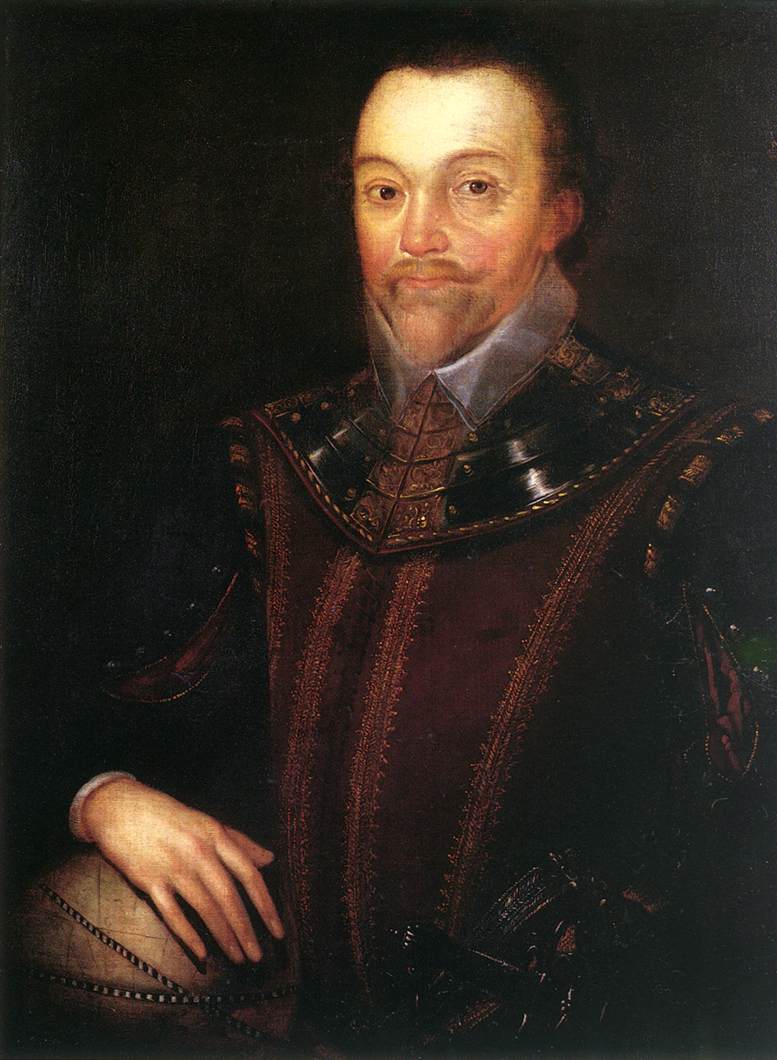Sir Francis Drake was an English mariner-adventurer, and sometime privateer, who circumnavigated the globe. Drake was born near Tavistock, Devon, England, not far from the important port of Plymouth. He came from a well-connected Protestant farming family, one of 12 children born to Edmund Drake.
At approximately age 13, Francis went to sea on a cargo bark and eventually became the master of the ship at age 20. These early seafaring years spent in the North Sea built his experience as a skillful sailor and navigator and gave him a sense of command. When he was 23 he joined his cousin Sir John Hawkins and for the first time voyaged to the New World. In association with Hawkins, he undertook the initial English slave-trading expeditions to the New World.
Drake discovered the lure of the Spanish Main with all its riches in silver, gold, and slaves. He disliked the Spanish from the onset, no doubt in part for their Catholicism, and in the 1560s, began his campaign against Spanish interests, appearing a pirate to some and a privateer to others. His raids demonstrated his bravado and determination, but almost cost him his life.
  |
Drake’s most famous attack came in 1573 when he took the Spanish Silver Train at the port of Nombre de Dios. Finding the silver too heavy to carry, he took all the gold he could and returned to Plymouth on August 9, 1573, with 30 survivors. Unfortunately, Queen Elizabeth I had undertaken a temporary truce with Philip II of Spain, and Drake’s exploits were not officially celebrated.
In 1577, Queen Elizabeth, facing new Spanish hostilities, sent Drake with 150 men and five ships on an expedition against the Spanish interests on the Pacific coast of the Americas. Two ships had to be abandoned at Río de la Plata and the remaining three navigated the Straits of Magellan, making Drake the first Englishman to do so.
The voyage continued to be difficult; another ship was destroyed, and still another separated and returned to England. Drake sailed along the coast of South America alone in the Golden Hind, attacking Spanish interests, plundering Valparaíso, and seizing cargo as he moved. He continued along the coast of North America looking for a passage to the Atlantic, possibly as far north as the present state of Washington.
 |
| Map that shows the circumnavigation travel of Francis Drake between 1577 and 1580 |
He stopped for supplies and repairs in San Francisco Bay and named the area New Albion. Drake now made the decision to cross the Pacific. He rounded the Cape of Good Hope and eventually returned on September 26, 1580, to Plymouth, laden with treasure. His exploits could not be denied even in the face of Spanish fury, and Queen Elizabeth knighted him.
War with Spain
Another war with Spain in 1585 put Drake back in his element. He took command of a fleet and launched assaults against Vigo in Spain, São Tiago in the Cape Verde Islands, and the New World
In 1587, he “singed the King of Spain’s beard” with a preemptive and destructive raid on Cádiz, burning 31 ships and holding the town for three days in the process. This attack delayed the Spanish Armada sailing by a year.
   |
By the time the Spanish Armada sailed to England to invade in 1588, Drake was vice admiral in command of the English fleet. It was at this time that the famous Drake myth first appeared that had Drake enjoying a game of bowls on Plymouth Hoe as the Spanish fleet approached. Here he supposedly stated that he had plenty of time to finish the game before the Spanish arrived.
The English fleet pursued the Spanish through the channel. Drake caught the rich galleon Rosario and Admiral Pedro de Vales in the process. On July 29, 1588, Drake and Lord Howard of Effingham organized the fire ships that broke the Spanish formation, causing damage that forced the Spaniards into the open sea toward Calais. The following day, Drake and the rest of the English fleet defeated the Spanish at the Battle of Gravelines.
Drake’s final expedition against the Spanish occurred in 1595, supported by Hawkins. On this occasion, the Spanish inflicted defeat, particularly against Drake’s raids on San Juan, Puerto Rico. Hawkins died off Puerto Rico and Drake became ill from dysentery and died on January 28, 1596, while in the process of mounting a further attack on San Juan. Placed in a lead coffin, Drake was buried at sea with his crew burning the town of Puerto Bello as a dedication to his passing.
Drake’s life was one of adventure and determination, which helped enrich England with his plunder. He established claims to the New World and made England a recognized naval power.
